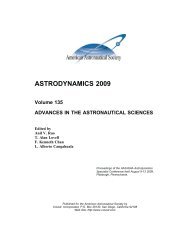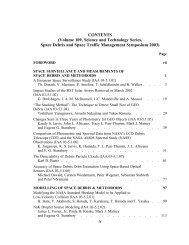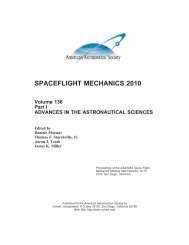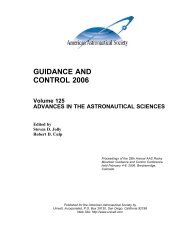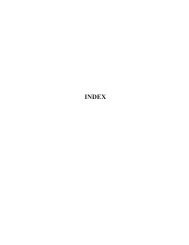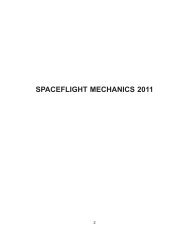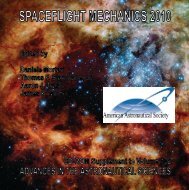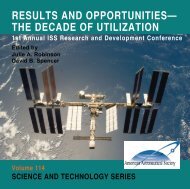Dynamics Analysis of Space Tether Missions - Univelt
Dynamics Analysis of Space Tether Missions - Univelt
Dynamics Analysis of Space Tether Missions - Univelt
You also want an ePaper? Increase the reach of your titles
YUMPU automatically turns print PDFs into web optimized ePapers that Google loves.
DYNAMIC ANALYSIS OF<br />
SPACE TETHER MISSIONS<br />
Volume 126<br />
ADVANCES IN THE ASTRONAUTICAL SCIENCES<br />
by<br />
Eu gene M. Levin<br />
Published for the American Astronautical Society by<br />
<strong>Univelt</strong>, Incorporated, P.O. Box 28130, San Diego, California 92198<br />
Web Site: http://www.univelt.com
Copyright 2007<br />
by<br />
AMERICAN ASTRONAUTICAL SOCIETY<br />
AAS Publications Office<br />
P.O. Box 28130<br />
San Diego, California 92198<br />
Affiliated with the American Association for the Advancement <strong>of</strong> Science<br />
Member <strong>of</strong> the International Astronautical Federation<br />
First Printing 2007<br />
Library <strong>of</strong> Congress Card No. 57-43769<br />
ISSN 0065-3438<br />
ISBN 978-0-87703-537-4 (Hard Cover)<br />
ISBN 978-0-87703-538-1 (S<strong>of</strong>t Cover)<br />
Published for the American Astronautical Society<br />
by <strong>Univelt</strong>, Incorporated, P.O. Box 28130, San Diego, California 92198<br />
Web Site: http://www.univelt.com<br />
Printed and Bound in the U.S.A.<br />
vi
CONTENTS<br />
Foreword . . . . . . . . . . . . . iii<br />
About the Book . . . . . . . . . . . 9<br />
NEW MISSIONS FOR SPACE TETHERS . . . . . 11<br />
1. HARPOONING A COMET<br />
COMET NUCLEUS SAMPLE RETURN . . . . . . 19<br />
Nomenclature . . . . . . . . . . . . 20<br />
1.1. Race to Comets and Asteroids . . . . . . . 21<br />
1.2. <strong>Tether</strong>-Mediated Sample Retrieval . . . . . . 24<br />
1.3. <strong>Space</strong>craft Motion in the Vicinity <strong>of</strong> the Comet . . . . 26<br />
1.3.1. Dynamic Models and Equations . . . . . . 26<br />
1.3.2. Hovering and Close Approach Trajectories . . . 29<br />
1.4. Equations <strong>of</strong> <strong>Tether</strong>ed Motion . . . . . . . 34<br />
1.4.1. Equations in a Newtonian Form . . . . . 34<br />
1.4.2. Equations in Minakov’s Form . . . . . . 36<br />
1.4.3. Equations for the Tangent Orientation Angles . . 39<br />
1.4.4. Calculation <strong>of</strong> the <strong>Tether</strong> Tension . . . . . 42<br />
1.4.5. Normalization <strong>of</strong> the Arclength . . . . . . 44<br />
1.5. <strong>Tether</strong> Deployment . . . . . . . . . . 45<br />
1.5.1. <strong>Tether</strong> Tension Range . . . . . . . . 45<br />
1.5.2. Deployment <strong>Dynamics</strong> . . . . . . . . 47<br />
1.5.3. Energy Considerations . . . . . . . . 49<br />
1.6. <strong>Tether</strong> Retrieval . . . . . . . . . . 52<br />
1.6.1. Retrieval <strong>Dynamics</strong> . . . . . . . . 52<br />
1.6.2. <strong>Dynamics</strong> <strong>of</strong> a Capsule Moving Along the <strong>Tether</strong> . . 55<br />
1.6.3. Other Scenarios . . . . . . . . . 58<br />
1.6.4. <strong>Tether</strong> Safety . . . . . . . . . . 59<br />
1.7. Conclusions . . . . . . . . . . . 60<br />
1
2 CONTENTS<br />
2. SURVIVING IN SPACE<br />
TETHER PHYSICS AND SURVIVABILITY EXPERIMENT . . 63<br />
Nomenclature . . . . . . . . . . . . 64<br />
2.1. The Story <strong>of</strong> Survival . . . . . . . . . 65<br />
2.2. Evolution Model . . . . . . . . . . 69<br />
2.2.1. Equations <strong>of</strong> Motiom . . . . . . . . 69<br />
2.2.2. Internal Friction in the <strong>Tether</strong> . . . . . . 71<br />
2.2.3. Pendular Motions . . . . . . . . . 72<br />
2.2.4. Forms <strong>of</strong> Small OScillations . . . . . . 74<br />
2.2.5. Modal Decomposition . . . . . . . . 76<br />
2.2.6. Equations <strong>of</strong> Libration . . . . . . . . 77<br />
2.2.7. Evolution Equations . . . . . . . . 78<br />
2.3. Non-Resonant Motions . . . . . . . . . 80<br />
2.4. Resonant Motions . . . . . . . . . . 83<br />
2.4.1. Poincare Maps and Resonance Zones . . . . 83<br />
2.4.2. Evolution in the Resonance Zone . . . . . 87<br />
2.5. Deployment <strong>Dynamics</strong> . . . . . . . . . 91<br />
2.5.1. Deployment and the Resonances . . . . . 91<br />
2.5.2. <strong>Tether</strong> Bow During and After Deployment . . . 94<br />
2.6. Thermal Effects . . . . . . . . . . . 97<br />
2.6.1. Thermal Hysteresis . . . . . . . . 97<br />
2.6.2. Thermal Cycles and Libration Evolution . . . . 99<br />
2.7. Rotation <strong>of</strong> the End-Bodies . . . . . . . . 101<br />
2.7.1. Alignment <strong>of</strong> the Spin Axis . . . . . . . 101<br />
2.7.3. Torsional Oscillations . . . . . . . . 103<br />
2.7.2. Interaction with Transverse Waves in the <strong>Tether</strong> . . 104<br />
2.8. Conclusions . . . . . . . . . . . . 105<br />
3. SAVING A SPACE STATION<br />
MIR ELECTRODYNAMIC TETHER SYSTEM . . . . 107<br />
Nomenclature . . . . . . . . . . . . 108<br />
3.1. <strong>Space</strong> Station in Trouble . . . . . . . . . 109<br />
3.2. Electrodynamic System Model . . . . . . . 112<br />
3.2.1. Equations <strong>of</strong> Motion . . . . . . . . 112<br />
3.2.2. <strong>Tether</strong> Heating . . . . . . . . . 114<br />
3.2.3. Electric Current in the <strong>Tether</strong> . . . . . . 115<br />
3.2.4. Geomagnetic Field Model . . . . . . . 116<br />
3.2.5. Calculating Geomagnetic Field Along the Orbit . . 118<br />
3.3. Pendular Motions . . . . . . . . . . 120<br />
3.3.1. Equations <strong>of</strong> Pendular Motion . . . . . . 120<br />
3.3.2. Operation Modes . . . . . . . . . 123<br />
3.3.3. System Characteristics . . . . . . . . 124
CONTENTS 3<br />
3.4. Librational Instability . . . . . . . . . 126<br />
3.4.1. Out-<strong>of</strong>-plane Instability . . . . . . . 126<br />
3.4.2. In-plane Instability . . . . . . . . 131<br />
3.5. Libration Control . . . . . . . . . . 132<br />
3.6. Attitude <strong>Dynamics</strong> <strong>of</strong> the <strong>Space</strong> Station . . . . . 134<br />
3.6.1. Equations <strong>of</strong> Mir’s Rotation . . . . . . 134<br />
3.6.2. Relative Equilibrium . . . . . . . . 139<br />
3.6.3. Small Oscillations . . . . . . . . . 140<br />
3.7. Resonant and Non-Resonant Motions . . . . . . 142<br />
3.7.1. Limitations on <strong>Tether</strong> Libration AMplitudes . . . 142<br />
3.7.2. Spectral <strong>Analysis</strong> <strong>of</strong> Free Oscillations . . . . 143<br />
3.7.3. Spectral <strong>Analysis</strong> <strong>of</strong> Forced Oscillations . . . . 145<br />
3.7.4. Non-Resonant Motions . . . . . . . 147<br />
3.7.5. Resonant Motions . . . . . . . . . 148<br />
3.8. Attitude Control . . . . . . . . . . 151<br />
3.8.1. Gyro-Damping . . . . . . . . . 151<br />
3.8.2. Attitude Control with Thrusters . . . . . . 154<br />
3.9. Transverse Oscillations <strong>of</strong> the <strong>Tether</strong> . . . . . . 154<br />
3.9.1. Equations <strong>of</strong> Transverse Oscillations . . . . . 154<br />
3.9.2. Linear Oscillations . . . . . . . . 157<br />
3.9.3. Modal Decomposition . . . . . . . . 159<br />
3.9.4. The Effect <strong>of</strong> Transverse Oscillations on Mir’s Rotation 164<br />
3.9.5. Controlling Transverse Oscillations . . . . . 164<br />
3.10. Torsional Oscillations <strong>of</strong> the <strong>Tether</strong> . . . . . . 166<br />
3.10.1. Rotation <strong>of</strong> the End-Body . . . . . . . 166<br />
3.10.2. Equations <strong>of</strong> Torsional Motion . . . . . . 168<br />
3.10.3. Torsional Eignefrequencies . . . . . . 169<br />
3.10.4. Evolution <strong>of</strong> Motion . . . . . . . . 170<br />
3.10.5. Thermal Effects . . . . . . . . . 171<br />
3.11. Longitudinal Damper . . . . . . . . . 173<br />
3.12. <strong>Tether</strong> State Estimation . . . . . . . . 174<br />
3.13. Conclusions . . . . . . . . . . . 179<br />
4. GOING FOR A SPIN<br />
ELECTRODYNAMIC DELIVERY EXPRESS . . . . . 183<br />
Nomenclature . . . . . . . . . . . . 184<br />
4.1. Perpetuum <strong>Tether</strong> Mobile . . . . . . . . 185<br />
4.2. Dynamic Model . . . . . . . . . . . 187<br />
4.2.1. Newtonian Formulation . . . . . . . 187<br />
4.2.2. Motion <strong>of</strong> the Center <strong>of</strong> Mass . . . . . . 189<br />
4.2.3. <strong>Tether</strong> Rotation . . . . . . . . . 190<br />
4.2.4. Small Oscillations . . . . . . . . . 191<br />
4.2.5. Minakov’s Formulation . . . . . . . 193
4 CONTENTS<br />
4.3. Operation <strong>of</strong> a Spinning <strong>Tether</strong> System . . . . . 196<br />
4.3.1. Electrodynamic Thrust . . . . . . . . 196<br />
4.3.2. Magnetic Field Along the Orbit . . . . . . 198<br />
4.3.3. Evolution <strong>of</strong> the Spin Axis . . . . . . . 199<br />
4.3.4. <strong>Tether</strong> Oscillations and Stability . . . . . 202<br />
4.3.5. Control <strong>of</strong> the Spinning <strong>Tether</strong> System . . . . 205<br />
4.4. Orbit Transfers with Spinning <strong>Tether</strong>s . . . . . . 208<br />
4.4.1. Equations <strong>of</strong> Orbit Evolution . . . . . . 208<br />
4.4.2. Optimal Current Scheduling . . . . . . 209<br />
4.4.3. Average Performance Characteristics . . . . 215<br />
4.4.4. Fastest Orbital Plane Change . . . . . . 218<br />
4.4.5. Orbital Plane Change Assisted by Altitude Change . . 224<br />
4.4.6. Fastest In-Plane Orbit Transfers . . . . . 226<br />
4.4.7. Elliptic Orbits with High Apogees . . . . . 230<br />
4.5. Attitude Motion <strong>of</strong> the End-Bodies . . . . . . 230<br />
4.6. Conclusions . . . . . . . . . . . 233<br />
5. CATCHING A PAYLOAD<br />
MOMENTUM EXCHANGE ELECTRODYNAMIC REBOOST<br />
SYSTEM . . . . . . . . . . . . . 235<br />
Nomenclature . . . . . . . . . . . . 236<br />
5.1. Electrodynamic <strong>Tether</strong> Transport . . . . . . . 237<br />
5.2. Dynamic Model . . . . . . . . . . . 241<br />
5.2.1. Equations <strong>of</strong> Motion . . . . . . . . 241<br />
5.2.2. Gravitational Field Model . . . . . . . 242<br />
5.3. Stationary Rotation . . . . . . . . . . 245<br />
5.4. Natural Forms <strong>of</strong> Oscillations . . . . . . . . 247<br />
5.4.1. Equations <strong>of</strong> Small Oscillations . . . . . . 247<br />
5.4.2. The Eigenvalue Problem . . . . . . . 248<br />
5.4.3. Eigenforms and Eigenvalues . . . . . . 249<br />
5.5. Decomposition <strong>of</strong> Motion . . . . . . . . 252<br />
5.5.1. General Equations . . . . . . . . 252<br />
5.5.2. Calculation <strong>of</strong> the Integrals <strong>of</strong> Tension . . . . 254<br />
5.5.3. The Case <strong>of</strong> a Perfectly Tapered <strong>Tether</strong> . . . . 255<br />
5.5.4. Coupled Longitudinal-Transverse Oscillations . . . 257<br />
5.6. Gravitational Forces . . . . . . . . . . 258<br />
5.6.1. Expansion <strong>of</strong> the Newtonian Term . . . . . 258<br />
5.6.2. General Power Series Expansion . . . . . 260<br />
5.6.3. Contribution <strong>of</strong> the Higher Order Terms . . . . 261<br />
5.7. Precision Simulation Model . . . . . . . . 262<br />
5.8. Minakov’s Formulation . . . . . . . . . 263<br />
5.8.1. Equations <strong>of</strong> Motion in Minakov’s Form . . . . 264<br />
5.8.2. Boundary Conditions . . . . . . . . 266
CONTENTS 5<br />
5.8.3. Motion <strong>of</strong> the Center <strong>of</strong> Mass . . . . . . 267<br />
5.8.4. Quasi-Static Tension . . . . . . . . 268<br />
5.8.5. Simulation Approach . . . . . . . . 271<br />
5.9. Resonant Excitation <strong>of</strong> Oscillations . . . . . . 273<br />
5.10. Non-Gravitational Perturbations . . . . . . . 274<br />
5.10.1. Method <strong>of</strong> Computation . . . . . . . 274<br />
5.10.2. Aerodynamic Forces . . . . . . . . 275<br />
5.10.3. Electrodynamic Forces . . . . . . . 275<br />
5.10.4. Solar Radiation Pressure . . . . . . . 275<br />
5.10.5. Thermal Expansion <strong>of</strong> the <strong>Tether</strong> . . . . . 276<br />
5.10.6. Creep in the <strong>Tether</strong> . . . . . . . . 277<br />
5.10.7. <strong>Tether</strong> Mass Loss . . . . . . . . 277<br />
5.11. Estimation and Control Approaches . . . . . . 280<br />
5.12. Conclusions . . . . . . . . . . . 280<br />
6. LISTENING TO THE ECHOES OF THE PAST<br />
SUBMILLIMETER PROBE OF THE EVOLUTION OF COSMIC<br />
STRUCTURE . . . . . . . . . . . . 283<br />
Nomenclature . . . . . . . . . . . . 284<br />
6.1. Observatories in <strong>Space</strong> . . . . . . . . . 285<br />
6.2. <strong>Tether</strong>ed Synthetic Aperture Interferometer . . . . 288<br />
6.3. Diamond Shape Configurations . . . . . . . 290<br />
6.3.1. Symmetry and Dynamic Balance . . . . . 290<br />
6.3.2. Synthetic Aperture Coverage . . . . . . 292<br />
6.4. Dynamic Model . . . . . . . . . . . 295<br />
6.4.1. Equations <strong>of</strong> Motion . . . . . . . . 295<br />
6.4.2. Gravitational and Non-Gravitational Forces . . . 297<br />
6.5. Stationary Motions . . . . . . . . . . 299<br />
6.5.1. Quasi-Rigid Motions . . . . . . . . 299<br />
6.5.2. Dynamic Symmetry and Integrals <strong>of</strong> Motion . . . 300<br />
6.5.3. <strong>Tether</strong> Tension in Stationary Motion . . . . 303<br />
6.6. Periodic Motions . . . . . . . . . . 305<br />
6.7. Controlled Motions . . . . . . . . . . 307<br />
6.7.1. <strong>Tether</strong> Tension Control . . . . . . . 307<br />
6.7.2. Controlling the Diamond Shape Configuration . . 309<br />
6.7.3. Changing the Spin Plane . . . . . . . 310<br />
6.7.4. Residual Out-<strong>of</strong>-Plane Oscillations . . . . . 312<br />
6.7.5. Variable Diamond Shape with Fixed <strong>Tether</strong> Lengths . 313<br />
6.8. <strong>Tether</strong> Oscillations . . . . . . . . . . 314<br />
6.8.1. <strong>Tether</strong> Design and Thermal Regime . . . . . 314<br />
6.8.2. Longitudinal Oscillations . . . . . . . 315<br />
6.8.3. Transverse Oscillations . . . . . . . 315<br />
6.8.4. Torsional Oscillations . . . . . . . . 317
6 CONTENTS<br />
6.8.5. The Effect <strong>of</strong> <strong>Tether</strong> Oscillations on the End-Bodies . 318<br />
6.9. Simulation Model . . . . . . . . . . 319<br />
6.9.1. Fast and Slow Components <strong>of</strong> Motion . . . . 319<br />
6.9.2. Difficulties <strong>of</strong> Numeric Integration . . . . . 320<br />
6.9.3. Relative Motion <strong>of</strong> the <strong>Tether</strong> . . . . . . 322<br />
6.9.4. Calculation <strong>of</strong> <strong>Tether</strong> Tension . . . . . . 326<br />
6.9.5. Modal Expansion . . . . . . . . . 329<br />
6.9.6. Simulation Approaches . . . . . . . . 330<br />
6.10. Conclusions . . . . . . . . . . . 331<br />
7. COLONIZING THE MOON<br />
LUNAR TRANSPORTATION SYSTEMS . . . . . . 333<br />
Nomenclature . . . . . . . . . . . . 334<br />
7.1. The Earth-Moon Highway . . . . . . . . 335<br />
7.2. Lunar <strong>Space</strong> Elevator Revisited . . . . . . . 337<br />
7.2.1. Transfer Trajectories to the Lunar Elevator . . . 337<br />
7.2.2. Equations <strong>of</strong> Motion and Relative Equlibrium . . . 340<br />
7.2.3. Characteristics <strong>of</strong> <strong>Tether</strong> Configurations . . . . 341<br />
7.2.4. Non-Equatorial Configurations . . . . . . 345<br />
7.2.5. Fail-Safe Elevator . . . . . . . . . 348<br />
7.3. Rotating Docking Port on the Moon . . . . . . 349<br />
7.3.1. The Concept . . . . . . . . . . 349<br />
7.3.2. Dynamic Features <strong>of</strong> the Rotating Port . . . . 352<br />
7.4. Conclusions . . . . . . . . . . . . 356<br />
8. FLYING IN FORMATION<br />
TRIANGULAR FORMATIONS OF TETHERED SATELLITES . 359<br />
Nomenclature . . . . . . . . . . . . 360<br />
8.1. Constellations, Clusters, and Formations . . . . . 361<br />
8.2. Triangular <strong>Tether</strong>ed Formations . . . . . . . 365<br />
8.2.1. Dynamic Model . . . . . . . . . 365<br />
8.2.2. Quasi-Rigid Rotation . . . . . . . . 368<br />
8.2.3. <strong>Tether</strong> Tension . . . . . . . . . 369<br />
8.2.4. Symmetrical Formations . . . . . . . 370<br />
8.3. Rotation and Precession . . . . . . . . . 372<br />
8.3.1. Spin Stabilization . . . . . . . . . 372<br />
8.3.2. Precession <strong>of</strong> the Spin Axis . . . . . . . 376<br />
8.3.3. Conical Precession . . . . . . . . 378<br />
8.3.4. Tidal Evolution . . . . . . . . . 383<br />
8.4. Electrodynamic Control . . . . . . . . . 386<br />
8.4.1. The effect <strong>of</strong> Ampere Forces . . . . . . 386<br />
8.4.2. Optimal Thrust . . . . . . . . . 389<br />
8.4.3. Electromagnetic Torque . . . . . . . 392
CONTENTS 7<br />
8.5. <strong>Tether</strong> Oscillations . . . . . . . . . . 395<br />
8.6. Tetrahedron Formations . . . . . . . . . 399<br />
8.7. Conclusions . . . . . . . . . . . . 400<br />
9. SETTING SAIL<br />
ELECTRODYNAMIC SAIL CONCEPT . . . . . . 403<br />
Nomenclature . . . . . . . . . . . . 404<br />
9.1. Large <strong>Space</strong> Structures . . . . . . . . . 405<br />
9.2. Electrodynamic Sail . . . . . . . . . . 408<br />
9.3. Sail <strong>Dynamics</strong> and Control . . . . . . . . 411<br />
9.3.1. Orbital Motion and Quasi-Rigid Rotation . . . 411<br />
9.3.2. Electrodynamic Thrust . . . . . . . . 413<br />
9.3.3. Electrodynamic Torque . . . . . . . . 414<br />
9.3.4. Modelling Sail Deformations . . . . . . 416<br />
9.3.5. Performance Characteristics . . . . . . 418<br />
9.3.6. Rendezvous with a Spinning Sail . . . . . 420<br />
9.4. Conclusions . . . . . . . . . . . . 421<br />
References . . . . . . . . . . . . . 425<br />
Subject Index . . . . . . . . . . . . 449<br />
List <strong>of</strong> Tables . . . . . . . . . . . . 453



